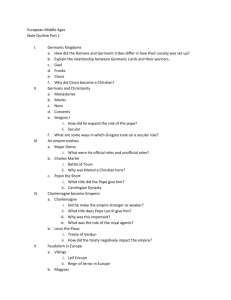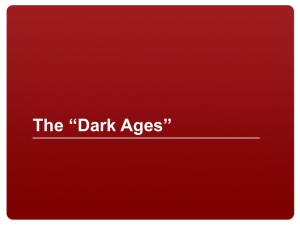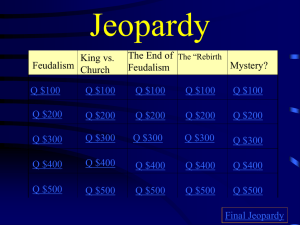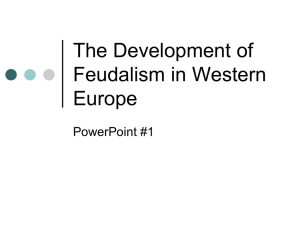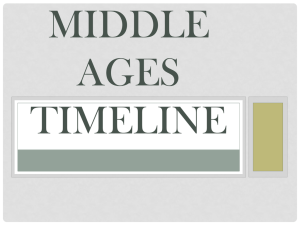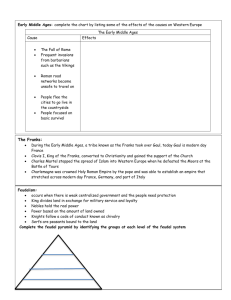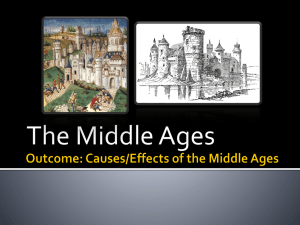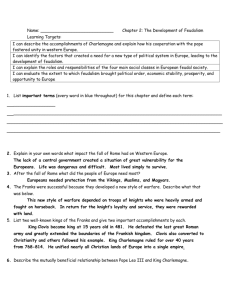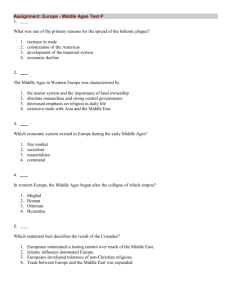Age of Reason - Manhasset Public Schools
advertisement
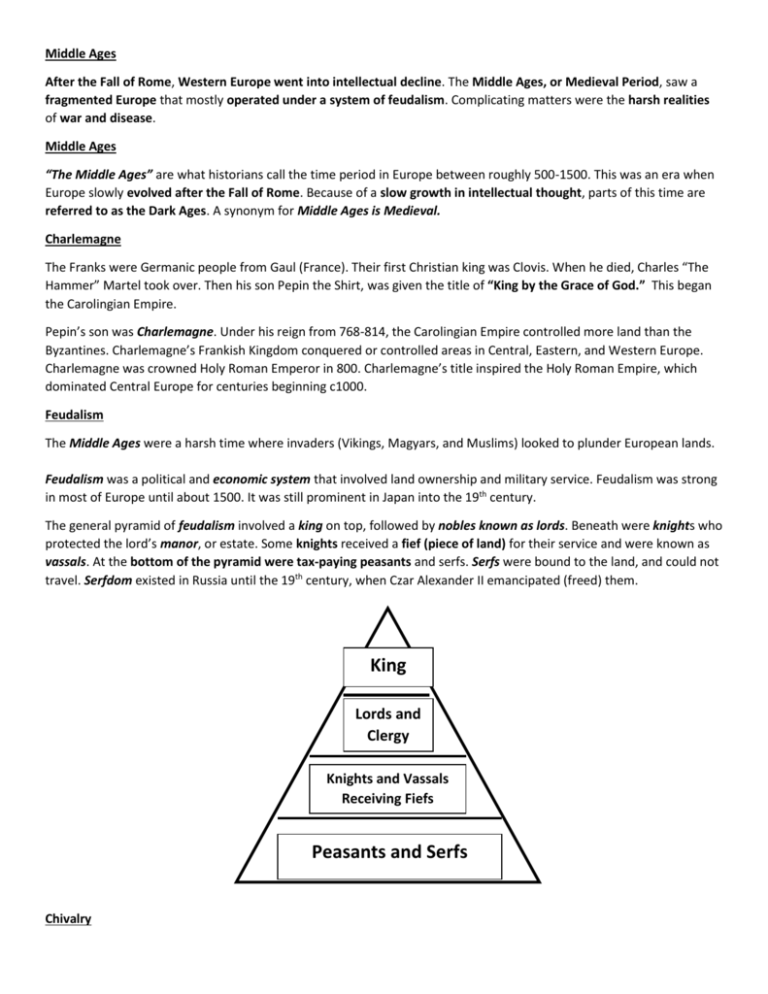
Middle Ages After the Fall of Rome, Western Europe went into intellectual decline. The Middle Ages, or Medieval Period, saw a fragmented Europe that mostly operated under a system of feudalism. Complicating matters were the harsh realities of war and disease. Middle Ages “The Middle Ages” are what historians call the time period in Europe between roughly 500-1500. This was an era when Europe slowly evolved after the Fall of Rome. Because of a slow growth in intellectual thought, parts of this time are referred to as the Dark Ages. A synonym for Middle Ages is Medieval. Charlemagne The Franks were Germanic people from Gaul (France). Their first Christian king was Clovis. When he died, Charles “The Hammer” Martel took over. Then his son Pepin the Shirt, was given the title of “King by the Grace of God.” This began the Carolingian Empire. Pepin’s son was Charlemagne. Under his reign from 768-814, the Carolingian Empire controlled more land than the Byzantines. Charlemagne’s Frankish Kingdom conquered or controlled areas in Central, Eastern, and Western Europe. Charlemagne was crowned Holy Roman Emperor in 800. Charlemagne’s title inspired the Holy Roman Empire, which dominated Central Europe for centuries beginning c1000. Feudalism The Middle Ages were a harsh time where invaders (Vikings, Magyars, and Muslims) looked to plunder European lands. Feudalism was a political and economic system that involved land ownership and military service. Feudalism was strong in most of Europe until about 1500. It was still prominent in Japan into the 19th century. The general pyramid of feudalism involved a king on top, followed by nobles known as lords. Beneath were knights who protected the lord’s manor, or estate. Some knights received a fief (piece of land) for their service and were known as vassals. At the bottom of the pyramid were tax-paying peasants and serfs. Serfs were bound to the land, and could not travel. Serfdom existed in Russia until the 19th century, when Czar Alexander II emancipated (freed) them. King Lords and Clergy Knights and Vassals Receiving Fiefs Peasants and Serfs Chivalry Chivalry was a code of conduct where a knight fought honorably for the lord and his lady. This was similar to the Japanese bushido code of the samurai warrior. Chivalry affected the way knights treated women. Though not equals, women were seen in a pure and virtuous light. Troubadours, or musicians in castles, sang about the themes of love and honor. What Should I Know about the Middle Age Economy? 1. It was most agricultural, with a three field system whereby land would be farmed in sections. One of these sections would be left unfarmed so the soil could rejuvenate. 2. Many worked in business and were artisans. The merchant class was known as burghers. Guilds, similar to today’s unions, protected the working rights of artisans of a similar craft. The guild members were masters of their trade. Before becoming a master, one had to be an apprentice for another master, and then a wageearning journeyman. 3. In Northern Europe near the Baltic Sea, there was a commercial organization known as the Hanseatic League. States in modern-day Germany, Sweden, Poland, Latvia, Estonia, and others formed this organization to protect trading rights such as freedom of the seas, and fair weights and measures. The League was strong from the 13th through 17th centuries. The Roman Catholic Church of the Middle Ages Because the Church was incredibly important and powerful, the Middle Ages was also known as the Age of Faith. You should know: 1. The Church was in charge of giving out sacraments (sacred rites) which were necessary for salvation, or going to heaven. The Church’s clergy was comprised of first the Pope, then archbishops and bishops, and finally local priests. The law of the church was called cannon law. 2. Lay investiture – this was when kings and rich nobles appointed religious officials. This would give them an unfair influence over the Church. Though the Church was powerful, activities such as lay investiture were viewed by many as corrupt. 3. Excommunication – this meant to kick one out of the Church. 4. The Church struggled for power with the Holy Roman Emperors. At the Concordat of Worms in 1122, the Pope and Emperor comprised their issues. 5. Still, corruption continued. Simony occurred when church positions were sold. 6. Churches were Romanesque and Gothic architecture styles. Romanesque churches were symmetrical with rounded arches and towers. Gothic churches were ornate with pointed arches, stained-glass windows, and flying buttresses that linked walls. 7. Some attacked the church, such as John Wycliffe and Jan Hus. Around 1380, Wycliffe said that Jesus Christ was the true head of the Church, not the Pope. Around 1400, Hus preached that the Bible was of a higher authority than the Pope. Hus was excommunicated and burned at the stake. The Crusades (1095-1291) These were religious wars fought between European Christians and Muslims from Africa and Asia Minor (Anatolia/Turkey). Both were fighting to secure the Holy Land of Jerusalem. In total, there were nine Crusades. The 1st Crusade was called for by Pope Urban II in 1095. The Crusaders were mainly Roman Catholic armored knights with crosses on their shields. They briefly captured land near Jerusalem, but could not hold onto it. Turks from the former Seljuk Empire of Anatolia prevented a Crusader victory. In the Second crusade, Jerusalem was taken by the Muslim commander Saladin. In the Third Crusade, Crusader and English King Richard the Lion heart reached an agreement that allowed Christians to enter the Holy Land as visitors in 1192. Though violent and creating much religious strife, the Crusades created new trade networks between Europe, Asia, and Northern Africa. Not only were goods and innovations exchanged, but scientific and mathematical though as well. The crusades further weakened the system of feudalism as money became more valuable and cities began to rise. Spanish Inquisition: This was a movement in Spain that looked to maintain the orthodoxy of the country through forced conversions and deportation. A tribunal interrogated those seen as heretics (people with beliefs that clashed with the Catholic Church). Typically the oppressed were Jews, Muslims, or recent converts to Christianity. Confessions were often forced through torture. Remnants of the inquisition existed into the 19th century. The Inquisition came amidst the Reconquista, which was a plan to remove Muslims from Spain. Christians kicked out the remaining Muslim kingdoms in 1492. For about the previous 800 years, the Moors (Muslim invaders from northern Africa) had conquered much of the Iberian Peninsula (Spain and Portugal). Great Schism (1379-1417) Unlike the schism of 1054 that divided religion between Eastern Orthodox and Roman Catholicism, this schism was within the Catholic Church. Two people declared themselves Pope; Pope Urban VI in Rome, and Clement VII in Avignon, France. Eventually, a different Pope was elected. Bubonic Plague/Black Death Approximately one-third of Europe’s population died of this dreaded disease. The plague was believed to be brought to Italy from Asia in 1348. It then spread to the entire contingent. The Black Death ultimately hurt the prestige of the Church as praters went unanswered. The plague further weakened the stability of the feudal system. Hundred Years War (1337-1453) England and France had a history of conflict. In 1066, William the Conqueror from Northern France (Normandy) took the English throne. His descendants continued to rule England. That included King Henry II, who married Eleanor of Aquitaine. She had been a wife to both and English and French king. This war wasn’t really 100 years But from 1337-1453 England and France were engaged in battle. In the war, a French girl named Joan of Arc saw visions from God and felt compelled to save France. Although Joan led the army to victory, she was later captured and accused of heresy and witchcraft. She was burned at the stake in 1431. The Hundred Years’ War was mostly a standoff, as England won very little territory by war’s end. __________________________________________________________________________________________________ The Renaissance This was a time period from about 1350-1550 that saw a “rebirth” of learning and culture. There was also a push for individualism, as unlike those born into wealth, a new merchant and artistic classic believed that one should be judged by achievements. The movement affected art, literature, political thought, and science. Why did the Renaissance Begin? Italy. Italy borders the Mediterranean, and is a perfect port for economic commerce and trade. In addition, Italy’s social roots were based on the classical traditions of Greco-Roman Culture. The Italian Renaissance was centered in Florence where the influential Medici family ruled the city by 1434. Humanism: Humanism was a cultural and philosophical movement that celebrated a person’s achievements. Whereas the Middle Ages stressed studying Christianity, humanism liked to investigate the classical teachings of ancient Greece and Rome. Humanists expanded education in subjects called humanities (social studies, literature, philosophy, languages). They wanted to secularize society, or make it worldly instead of religious. Whereas Medieval art was concerned with religious themes that were often out of proportion, many of the Renaissance paintings were secular and done in realism. This meant breathtaking detailed images proportional to the human body, Renaissance art was colorful and done in perspective, or three dimensions. Some artists to know are: 1. Michelangelo – His Statue of the David was completed in 1504 and today can be found in Florence. The statue is both a symbol of strength and a celebration of the human body. Michelangelo also painted the celling of the Sistine Chapel in Rome (Vatican City). He sculpted the Pieta which portrays the Virgin Mary holding her son Jesus after the crucifixion. The statue is currently at St. Peter’s Basilica in Vatican City. 2. Raphael – He painted Madonna and Child. He also painted the School of Athens, which is a c1510 Masterpiece where Plato walks with Aristotle. It is a fresco, which is a work of art painted on damp plaster, typically on walls. 3. Leonardo da Vinci – c1500, he was truly a “Renaissance Man,” as his talents went beyond art. Among other things he was an inventor, scientist, sculptor, and writer. His best known paintings were the Mona Lisa and the Last Supper. In both, one can sense the emotions of the subjects. Johann Gutenberg’s Printing Press: Literature became more widely available because of Johann Gutenberg’s invention of the printing press. The Gutenberg Bible was one of the earliest works printed in Europe. Because of this new use of movable type, learning spread throughout Europe at a much faster pace. Further increasing education, many writers abandoned Latin and wrote books in vernaculars, or local/native tongues. The Prince: Niccolo Machiavelli wrote The Prince in 1513. In this work he explained that a strong leader must rule harshly to keep order. Otherwise, people would walk all over that leader. Therefore, a ruthless personality is needed to not only secure power, but hold onto it. What was the Protestant Reformation: This was a movement by people who protested, and wanted to reform (change for the better) the Roman Catholic Church. From 1517 through the next century, new sects of Christianity were formed. What were the Causes of the Reformation? For centuries there had been critics of the Roman Catholic Church, such as John Wycliffe and Jan Hus during the Middle Ages. By 1500, the causes for discontent were: 1. Selling of indulgences: An indulgence allowed people to sin without being punished. Dominican priest Johann Tetzel sold these pardons to raise money to renovate St. Peters Cathedral in Rome. 2. Resentment to the power of the Pope and Clergy. 3. A belief that the Bible was far more important than the power of church officials. Martin Luther / 95 Theses: On October 31, 1517, a religious monk named Martin Luther hammered a list of grievances to a church in Wittenberg, Germany. These were the 95 Theses. They were quickly copied and distributed throughout Germany and Western Europe. The main ideas of the Theses were that: 1. The Bible was the authority of Christianity, not the clergy. 2. Only God could give salvation to heaven. 3. To get into heaven. One must have faith and do good deeds/works 4. Church practices created during the Middle Ages were not binding. 5. Luther also attached the selling of indulgences. These ideas helped start the Protestant Reformation. What was the Church’s reaction to Luther’s Ideas? Pope Leo X excommunicated Luther (kicked him out of the Church) when he refused to take back his words. In 1521, Luther stood trial in front of the Diet (assembly) of Worms at Worms, Germany. Again, he wouldn’t retract his statements. Holy Roman Emperor Charles V issued the Edict of Worms, which labeled Luther a heretic. It also banned his writings and ideas. Still, Lutherans followed his teachings. The Scientific Revolution: The Scientific Revolution was a new sequence of investigation that was used to new sequence of investigation that was used to test a hypothesis through experimentation. After logical steps were taken, a conclusion could be derived. What to know about the Scientific Revolution: 1. Heliocentric Model: This was Nicolaus Copernicus’ belief that the planets revolved around the sun. This idea contrasted with the geocentric model that declared the Earth as the center of the Universe. 2. Galileo Galilei: He was a scientist who discovered that objects of different weights fall at the same speed (this went against Aristotle’s theory). He also observed the moons of Jupiter and confirmed Copernicus’ theories. His findings upset the Church, and at trial he was forced to retract his observations. Despite his retraction, Galileo spent his remaining days under house arrest. 3. Isaac Newton – Researched universal gravitation and created three laws of motion. The Age of Absolutism For centuries, absolute monarchs ruled Europe. In most cases, individual rights were limited and kings grew stronger. Because the monarch claimed to be a representative of God, few questioned the extent of their power. However, in the seventeenth century a movement in philosophy known as the Enlightenment began. Popular philosophical thought led to a demand for natural rights and liberty. Some monarchs extended rights to their people. Others did not. By the middle of the eighteenth century, demands for freedom grew louder and more violent. The Age of Absolutism: Monarchs (kings and queens) ruled with complete power from c1500-c1740. As seen in ancient China (Mandate of Heaven) and Egypt (theocracy), there was a belief that the king was the representative of God. In Europe, this theory was called divine right. Louis (Bourbon) XIV – France: Louis XIV was the prototypical absolute ruler c1700. Nickname “The Sun King,” Louis said “I am the state.” He expanded the Palace of Versailles into one of the most elaborate compounds in the world. Complete with thousands of rooms, ornate statues, and extensive gardens, this symbol of France was built at the expense of the suffering and starving peasants. Louis XIV fought many wars during his 72 year reign. Although France became a strong force, weaker countries teamed up against them to keep French territorial gains minimal. During his rule, the debt of the country increased because of his lavish spending. Peter the Great: Peter Romanov was a czar who wanted to imitate Western Europe, or westernize c1680. This meant to modernize Russia militarily, culturally, economically, and technologically. Peter traveled to the west with his army. Examples of westernization were: increasing the size of the army, expanding education, and moving Mongol influence from society in the way people dressed and presented themselves. Because all great nations of the West had impressive capitals, the new city of St. Petersburg was constructed in Russia, It was built with serf labor. Peter the Great also raised the status of women. In addition to easing restrictions on dress, he allowed women to mingle with men at social gatherings. Furthermore, he encouraged greater education opportunities for women. Stuarts of England: Charles I – He did not consult Parliament in governing affairs, and ruled absolutely. Charles and his supporters, known as Cavaliers, were defeated by General Oliver Cromwell in the Puritan Revolution/English Civil War. (1642-1649). Charles was brought to trial by the Puritan victors, and was executed for treason. Cromwell ruled as a military dictator until 1658. James II – took power in 1685 and favored Catholicism. This upset English Protestants, including his daughter Mary. Mary, aided by her husband, a Dutch prince, Mary overthrew James in the bloodless Glorious Revolution of 1688. Constitutional / Limited Monarchy: Under the rule of William and Mary, the absolute monarchy ceased to exist, Instead, a new limited, or constitutional, monarchy prevailed with Parliament having immense strength in the creation of laws. Parliament drafted the Bill of Rights in 1689 to ensure freedom of speech, fair taxation, and other personal liberties. To recap, the three documents. 1. Magna Carta – 1215 – The Great Charter was forced upon King John to sign. This document limited the king’s power and gave rights to people. 2. Habeas Corpus Act – 1679 – Guaranteed the accused the right to go before a judge 3. Bill of Rights – 1689 The Enlightenment: The Enlightenment was mostly a political movement, but it coincided with new discoveries in science. Philosophers such as Francis Bacon and Rene Descartes attacked the scientific conclusions made by Aristotle. Descartes relied on math and reason to prove his theories. The Enlightenment / Age of Reason of the Eighteenth Century: Coinciding with the Scientific Revolution was the Enlightenment. This Age of Reason was a movement, mostly in the eighteenth century, that looked to reform (progressively change) society through knowledge and reason. A goal of most Enlightenment thinkers was to protect Natural Rights. Which Enlightenment Writers Should I know? Enlightenment philosophers used reason to define the liberties they thought people should have in nature. You should know: 1. Thomas Hobbes (English) – Leviathan, 1651. He believed that people created government, calling this notion a “social contract.” A Leviathan is a monster, and a metaphor for government. Like Machiavelli before him, Hobbes believe that people are greedy and need to be keep in check by a strong and absolute ruler. Many of these ideas were shaped by his personal experience witnessing the English Civil War. Despite his support for monarchy, Hobbes is included in the Enlightenment. 2. John Locke (English) – Two Treatises of Government, 1689. He believed that people were born free with natural rights such as life, liberty, and property. His ideas were adopted by Thomas Jefferson in the American Declaration of Independence. 3. Jean-Jacques Rousseau (French) – Social Contract, 1762. He said that government should rule for the common good. A famous quote of his was that, “Man is born free, and everywhere he is in chains.” Here, Rousseau was describing unjust laws which prevent natural rights and liberty. 4. Baron de Montesquieu (French) – The Spirit of Laws, 1748. He illustrated the concept of separation of powers, where the legislative branch (make laws), executive branch (enforces laws), and judicial branch (interprets laws) controlled the government. All three would operate under a system of checks and balances that would prevent one branch from getting too strong. Separation of powers was adopted by numerous nations, including the United States. 5. Voltaire (French) – In the eighteenth century he wrote hundreds of essays regarding the themes of freedom of speech, religion, and other social reforms. He was a supporter of separation of church and state. 6. Mary Wollstonecraft (English) - In 1792, this British activist published A Vindication of the Rights of Woman. She argued that women should receive an equal education to men, and should participate in politics and the economy outside of the home. Still, it would be decades before women received equality in Europe. Enlightened Despots: A despot is another term for an absolute ruler. Enlightened despots were those who supported the Age of Reason. Rulers such as Frederick the Great of Prussia and Catherine the Great of Russia supported modernization. They embraced the arts, education, religious toleration, and an end to certain torture punishments. __________________________________________________________________________________________________ 1. Religion and the Peace of Westphalia were associated with which war? A. Thirty Years’ War B. War of Spanish Succession C. War of the Australian Succession D. Seven Years’ War 2. Which of the following best describes the heliocentric model? A. The Earth and planets revolve around the sun B. A body in motion stays in motion C. The Earth is at the center of the universe D. Planets and the sun all revolve around the earth 3.The laws of gravity are attributed to which scientist? A. B. C. D. Isaac Newton Andreas Vesalius Nicolaus Copernicus Rene Descartes 4. Belief in life, liberty, and property are most associated with the findings of A. Jean-Jacques Rousseau B. John Locke C. Voltaire D. Baron de Montesquieu 9. In the Spirit of the Law, Baron de Montesquieu advocated for A. Speech rights B. Separation of powers C. Property qualifications to vote D. Freedom of Religion

